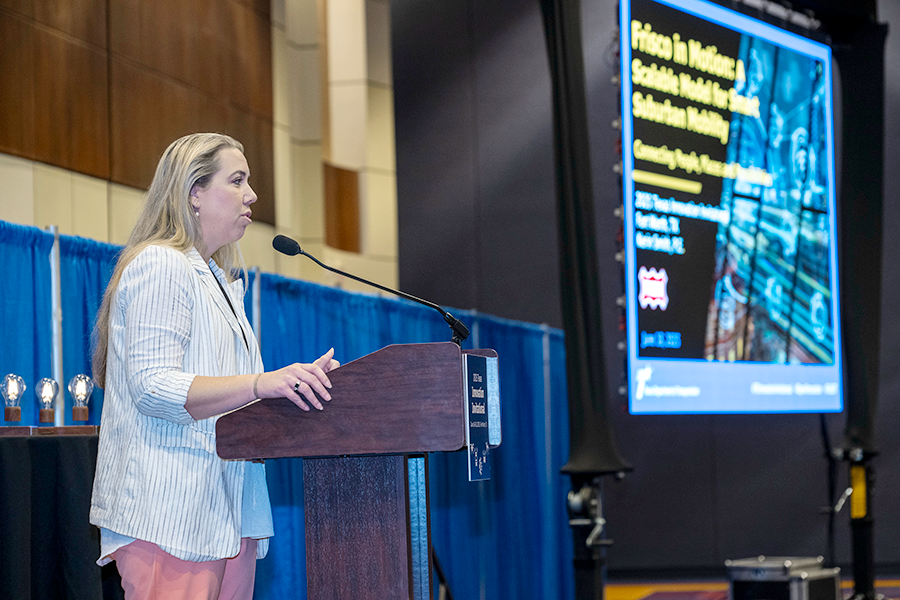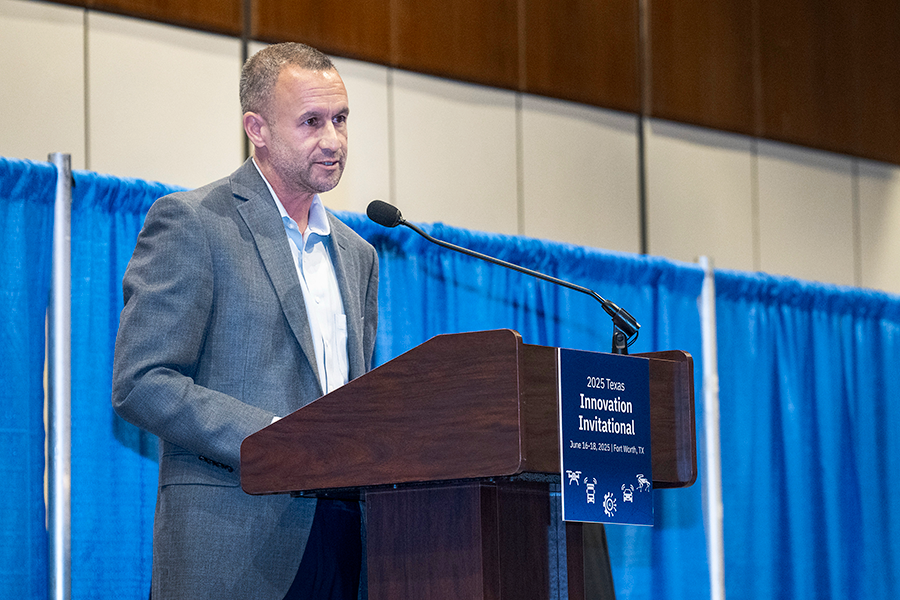At the 2025 Innovation Invitational, local government teams from across the state presented project ideas to solve mobility challenges in their region. The teams received real-time feedback from a panel of experts who considered the projects for the STAR (Smart Transportation and Advanced Roadway) award and an opportunity to receive grants of up to $125,000 from the State Transportation Innovation Council (STIC) Incentive program.
Winning teams: Team East Texas, Team Frisco, and Team Permian Basin.

Team East Texas
Integrating Digital Twin Technology for Predictive Maintenance in Rural Transit
- Presenter: Baylea Evans
- Project Lead: GoBus (East Texas Council of Governments Rural Transit)
Project abstract
GoBus proposes a pilot to implement Digital Twin technology to modernize fleet maintenance operations. Through IoT-enabled vehicle monitoring and AI-based analytics, the project aims to improve reliability, reduce downtime, and transition from reactive to predictive maintenance. This effort supports GoBus’s shift to in-house maintenance and sets the foundation for a data-informed, scalable strategy tailored to rural operations.
- Technology Areas: Digital Twin, AI
- Project Location: GoBus service area: 14 counties in East Texas
Challenge definition and background
Operating in a rural environment presents unique challenges such as inconsistent cellular connectivity, longer distances between service points, and increased wear on vehicles due to varied terrain. At present, GoBus does not have a robust predictive maintenance model, and maintenance remains primarily reactive. This pilot represents the first step in using AI and IoT technologies to build a data-informed maintenance strategy.
Through the installation of IoT sensors on a select group of vehicles, we will create digital twins, or virtual models, that mirror the real-time condition and performance of each bus. These virtual models will collect and analyze operational data using AI algorithms to detect early signs of component failure and predict future maintenance needs. This approach will allow GoBus to begin transitioning from reactive to predictive maintenance, improving vehicle reliability, optimizing service delivery in hard-to-reach areas, and have the potential to aid other local transit agencies in the East Texas region.
Ultimately, the insights gained from this pilot will inform a scalable roadmap for digital twin integration across the full fleet, helping GoBus create a smarter, more resilient maintenance system tailored to the realities of rural transit.

Team Frisco
Frisco in Motion: A Scalable Model for Smart Suburban Mobility
- Presenter: Kerin Smith
- Project Lead: City of Frisco
Project abstract
The City of Frisco is launching a new public transit system, beginning with on-demand microtransit and a future circulator service. A dedicated Mobility Hub will serve as the long-term anchor, connecting these modes and enhancing user access to multiple transportation options. This integrated approach offers a valuable opportunity to study rider behavior, mode-shift preferences, and regional coordination in a fast-growing, car-centric community.
- Project Partners: NCTCOG, Via, Denton County Transit Authority Technology Areas: Connected and Autonomous Vehicles, Microtransit
- Project Location: Downtown Frisco
Challenge definition and background
- Design and activate a centralized, tech-enabled Mobility Hub pre-wired for dynamic signage, rider analytics, and real- time displays
- Integrate shared mobility and curbside options with signage, AV wiring, and real-time data
- Research user adoption patterns and system performance to support future scaling
- First-of-its-kind model for a suburban city introducing transit from scratch
- Expanded Mobility Options: Introduce flexible, demand-responsive service in a non-transit city
- Improved Access: Connect residents to key destinations via microtransit and shared modes
- Infrastructure Readiness: Demonstrate use of a tech-enabled hub for future AV and multimodal integration
- Performance Measures: microtransit ridership trends and app engagement; hub amenity utilization (charging, seating, access control); curb activity: rideshare turnover, bike/scooter check-ins; community survey data on mode preference and satisfaction
This project can be an example for a flexible, tech-enabled mobility solution tailored to suburban contexts. This project will research user preferences and behavior related to mode choice in suburban contexts.

Team Permian Basin
Moving the Permian: A Safety and Multimodal Plan
- Presenter: Gabriel McLelland
- Project Lead: City of Midland
Project abstract
The Permian Basin region faces rising congestion, freight demands, and safety concerns along SH 191, its most heavily trafficked corridor. This project proposes to deploy adaptive traffic signal technologies and integrated data systems to improve commuter efficiency, emergency response, and multimodal safety, laying the foundation for coordinated, regional-scale traffic management.
- Project Partners: City of Odessa, Midland County, Ector County, PBMPO, TxDOT, DPS, FHWA, Law Enforcement & Fire Departments
- Technology Areas: Smart Infrastructure, Data
- Project Location: SH 191/BS 158 Corridor, Permian Basin Region
Challenge definition and background
- Deploy NoTraffic AI for adaptive signal timing at key intersections
- Enable real-time data feeds on crashes, equipment status, and pedestrian activity
- Build interagency systems for emergency coordination and proactive design
- Expand smart infrastructure to adjacent arterial roads
- Improved Travel Time Reliability: Reduce delays along SH 191 and parallel routes
- Enhanced Safety: Lower red-light running and improve pedestrian signal timing
- Data-Driven Planning: Align regional entities on shared, real-time performance metrics
- Emergency Responsiveness: Accelerate detection and dispatch across jurisdictions
The approach supports phased regional expansion—beginning with SH 191 intersections and extending to arterials and secondary roads. Enhanced data sharing and cross-agency collaboration will support long-term mobility in the Permian Basin region.
All competing teams
Presenter: Ann Foss
Project Lead: City of Arlington
Project Abstract: As the City prepares our safety action plan, called Safe Streets Arlington, a key safety concern heard from stakeholders and the public, and supported by crash data analysis, focuses on visibility and lighting to improve safety on our roadways. The City proposes to use data from the Safe Streets Arlington Plan to identify locations for installation of lighting improvements, coupled with technology that can help us monitor safety, identify additional safety concerns at these locations, remotely signal maintenance needs, and track safety improvements after the installation.
Presenter: Jo Namayanja
Project Lead: CapMetro
Project Abstract: Following a successful Phase 1 deployment of a Level 4, 40’ battery electric bus (BEB) in live yard conditions, CapMetro now aims to scale its autonomous yard operations. Phase 2 will expand vehicle integration, advance dispatch capabilities, and focus on workforce development to enable remote, driverless yard functions across a broader fleet.
Presenter: Uday Kari
Project Lead: City of Bryan
Project Abstract: The City of Bryan developed a proof-of-concept system that addresses cybersecurity and communications gaps to deliver real-time signal performance insights. This project aims to move from proof-of-concept to a fully automated deployment that ingests signal data and processes real-time information to reveal performance insights, all through a cybersecure framework. The vendor-agnostic approach is designed to scale statewide regardless of controller type or communications infrastructure.
Presenter: Gadimi Hilton
Project Lead: City of Fort Worth Transportation and Public Works
Project Abstract: Fort Worth is deploying a weather sensing network designed to close critical micro-weather data gaps for transportation safety and efficiency. Using an array of advanced sensors from multiple vendors, the project will support safer routing for freight, advanced air mobility, and AVs, particularly during severe or highly localized weather events.